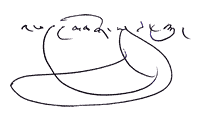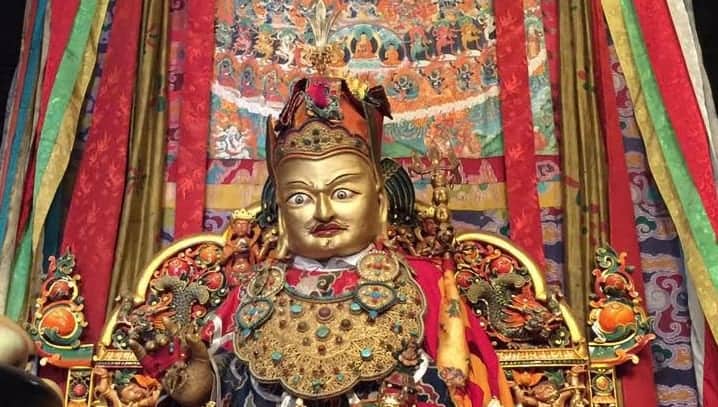Dear friends near and far,
As always, I hope this message finds you well, healthy and happy. On this Guru Rinpoche day, I would like to share with you all some of Guru Rinpoche’s precious pith instructions, from the fourth chapter of the Dispeller of All Obstacles (Tukdrup Barché Künsel), “Quintessential, All-Embracing Wisdom” (Yangtik Yeshé Zangtal). These are mainly instructions on Guru Yoga among the four foundations, as well as an introduction to the generation stage among the stages of generation, completion with characteristics, completion without characteristics, and the supreme completion stage of the Great Perfection (Dzokchen):
Practice outwardly by way of supplication; Practice inwardly by way of recitation; At the end, receive the four empowerments And dissolve the Guru into yourself. In the luminous state of the indivisibility Of the Guru and your own mind, Meditate one-pointedly on the ultimate, secret Guru. All phenomena of the relative and ultimate truths Are the great dharmakāya of superior indivisibility of the two truths. Through this yoga of the basic space of suchness, great emptiness, The true state of luminosity will manifest at death. Beings throughout space have not realized this— By way of illusory, non-conceptual compassion for them, Cultivate the all-illuminating samadhi. Through it, the bardo will manifest In the form of deities of the web of illusion. In particular, to purify the stages of birth, Practice the generation stage, Which stops clinging onto ordinary appearances.
First, I have to say to you that these days in the world, many people know some Dharma, or wish to practice. However, due to our backgrounds, life experiences, habits, and characters, we often don’t understand the Dharma’s key points. We cherry-pick the teachings in our practice, and therefore do not reach genuine results. I have seen this many times, so I would like to share with you some key advice based on my own experience.
Among the four foundations, Guru Yoga is the most important. Guru Yoga consists in seeing the Guru as a buddha; perceiving all the Guru’s activities as awakened activity; knowing the Guru to be the embodiment of all buddhas, superior in kindness even to the Buddha; knowing their nature to be the three kayas, indivisible from the nature of our mind; and seeing all that arises within appearance and existence as the Guru. Having complete trust and faith in all of this is extremely difficult. However, if you are able to practice Guru Yoga correctly, that is sufficient to achieve the supreme siddhis, and to realize the nature of mind. This has been taught in all the lineages of Mahamudra and the Great Perfection, the lineages of the vidhyadharas and siddhas, and the lineage of blessings.
So how do we practice Guru Yoga? First, outwardly, we supplicate Guru Rinpoche; then, inwardly, we do the recitation and receive the four empowerments; finally, secretly, we mingle our minds indivisibly with the Guru.
Some do not understand the purpose of Guru Yoga, and think it’s all brainwashing for the guru to control them. That is a possibility, but that’s why it’s so important to be a genuine student who follows a genuine guru from a genuine lineage with genuine instructions. One shouldn’t just practice Guru Yoga with any guru, any student, any teaching, or any lineage… All of these need to be genuine. What then is a genuine guru? One who has genuine experience and realization of the Dharma’s key points, so that experience and realization arise uninterruptedly in their mind streams. A genuine guru recognizes the view, remains in meditation, and acts according to what is to be adopted and what is to be abandoned. In this way, they are authentic in Body, Speech, and Mind.
However, it can be very difficult for students to determine whether a guru is genuine or not. That is why we first need to study the Dharma, receiving teachings, and understanding the key points. Then, we need to make aspirations to gather the accumulations and purify the obscurations. Finally, we need to supplicate Guru Rinpoche, the lineage masters, the Buddhas and bodhisattvas, and the Three Jewels.
Then comes the generation stage, which many students today disregard, thinking it’s mere ritual and visualization, a game of the imagination. This is completely mistaken. Students wish to practice the bardo teachings while looking down upon the generation stage, not understanding that the generation stage prepares us for the bardo. In wishing to receive bardo teachings, however, students are correct: my kindest root guru, Kyabje Tulku Urgyen Rinpoche, also said that Dharma students must train for the bardo, lest they miss the opportunity of liberation.
With regards to the bardo, Guru Rinpoche said that the relative and ultimate are the superior indivisibility of the two truths, the great dharmakaya. We use the term “superior” because this refers to the recognition that all relative appearances are the pure nature of the deity, not impure delusion, but the inseparability of the five kayas and five wisdoms. Their essence is the dharmakaya, emptiness or the basic space of phenomena. This is the ultimate Mahayoga view, seeing all relative appearances as the deities’ forms, whose essence is emptiness, the dharmakaya; and that is what we call the superior indivisibility of the two truths. It is superior because in the Sutra context, the purity of all relative appearances is only implied, not explicitly taught.
In terms of practice, we need to establish the three samadhis: the samadhi of suchness, the all-illuminating samadhi, and the causal samadhi. The samadhi of suchness is the nature of mind, emptiness, recognizing rikpa and remaining within that state. Among the three kayas, this corresponds to the dharmakaya. With this practice, in the bardo of the time of death, we can recognize the dharmakaya and be liberated into it. Therefore, the samadhi of suchness is the method for dharmakaya liberation.
The all-illuminating samadhi is compassion. What is the benefit of compassion? Among the three kayas, it corresponds to the sambhogakaya. In the bardo of dharmata, it is the method for recognizing the dynamic display as the lords of the five buddha families, and thereby being liberated into the sambhogakaya.
The causal samadhi is the indivisibility of compassion and emptiness arising in nirmanakaya form as a seed syllable. Thus, in the generation stage, the first support of our visualization is a syllable. This is the first door into the generation stage, because its purpose is to purify our clinging onto ordinary, impure appearances, our delusion of self and other. Among the three kayas, this corresponds to the nirmanakaya. In terms of its benefits, the causal samadhi is the method and the auspicious connection for being liberated in the bardo of becoming and reborn in the nirmanakaya pure realm.
Thus, through the power and blessings of each of the three kayas, we can be liberated into each type of pure realm. This is achieved by purifying each of the three bardos through the three samadhis, which clear away the bardos’ habitual tendencies. The samadhi of suchness purifies the bardo of the time of death and leads to the dharmakaya pure realm. The all-illuminating samadhi purifies the bardo of dharmata and leads to the sambhogakaya pure realm. The causal samadhi purifies the bardo of becoming and leads to the nirmanakaya pure realm.
Modern students who disregard the generation stage don’t receive the blessings of the guru, and do not reach certainty either through faith or through knowledge. Since they acquire neither stable faith nor wisdom, they are lacking the foundations of practice. That is why they do not receive blessings, and their practice doesn’t bring the desired results. We need to check ourselves and our own understanding of the generation stage in order to avoid this pitfall.
There really is no reason for any of you to disregard the profound generation stage of Secret Mantra. Doing so is like disregarding compassion and relative bodhicitta on the Sutric path. In the context of Sutra, if you disregard compassionate means, or the accumulation of merit, you won’t gather the accumulation of wisdom. Without the perfections of generosity, discipline, patience, diligence, and meditation, there is no reaching the perfection of wisdom. In the same way, without relying on the generation stage, there is no way to practice the completion stage.
Therefore, for anyone who is practicing now, currently has the wish to practice or even might wish to practice in the future, it is essential to understand the main points of the Dharma and to practice accordingly. If you practice willy-nilly, you will achieve willy-nilly results—only by practicing what is taught can you likewise reach the results that have been taught.
May the blessings of the Mahaguru who embodies the three roots infuse your body, speech and mind. Sarva Mangalam.

Translations
简体中文
繁體中文
Français
Deutsch
Ελληνικά
Bahasa Indonesia
Português
Русский
Español
ภาษาไทย
Українська
Tiếng Việt






Responses